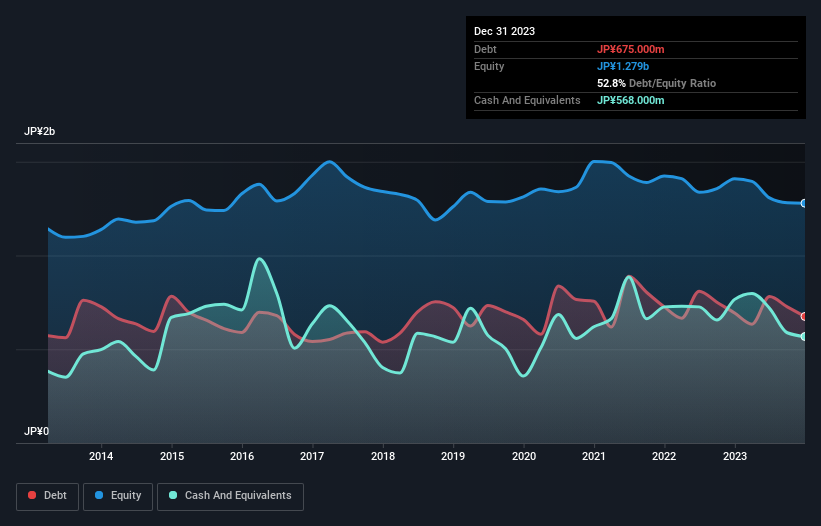
Legendary fund manager Li Lu (who Charlie Munger backed) once said, 'The biggest investment risk is not the volatility of prices, but whether you will suffer a permanent loss of capital.' So it might be obvious that you need to consider debt, when you think about how risky any given stock is, because too much debt can sink a company. We can see that Aso Foam Crete Co., Ltd. (TSE:1730) does use debt in its business. But should shareholders be worried about its use of debt?
Why Does Debt Bring Risk?
Debt and other liabilities become risky for a business when it cannot easily fulfill those obligations, either with free cash flow or by raising capital at an attractive price. In the worst case scenario, a company can go bankrupt if it cannot pay its creditors. However, a more common (but still painful) scenario is that it has to raise new equity capital at a low price, thus permanently diluting shareholders. Having said that, the most common situation is where a company manages its debt reasonably well - and to its own advantage. When we think about a company's use of debt, we first look at cash and debt together.
View our latest analysis for Aso Foam Crete
What Is Aso Foam Crete's Debt?
The chart below, which you can click on for greater detail, shows that Aso Foam Crete had JP¥675.0m in debt in December 2023; about the same as the year before. On the flip side, it has JP¥568.0m in cash leading to net debt of about JP¥107.0m.

How Healthy Is Aso Foam Crete's Balance Sheet?
According to the last reported balance sheet, Aso Foam Crete had liabilities of JP¥1.13b due within 12 months, and liabilities of JP¥816.0m due beyond 12 months. Offsetting these obligations, it had cash of JP¥568.0m as well as receivables valued at JP¥621.0m due within 12 months. So its liabilities outweigh the sum of its cash and (near-term) receivables by JP¥754.0m.
While this might seem like a lot, it is not so bad since Aso Foam Crete has a market capitalization of JP¥2.15b, and so it could probably strengthen its balance sheet by raising capital if it needed to. But it's clear that we should definitely closely examine whether it can manage its debt without dilution. There's no doubt that we learn most about debt from the balance sheet. But it is Aso Foam Crete's earnings that will influence how the balance sheet holds up in the future. So if you're keen to discover more about its earnings, it might be worth checking out this graph of its long term earnings trend.
Over 12 months, Aso Foam Crete made a loss at the EBIT level, and saw its revenue drop to JP¥3.3b, which is a fall of 12%. We would much prefer see growth.
Caveat Emptor
Not only did Aso Foam Crete's revenue slip over the last twelve months, but it also produced negative earnings before interest and tax (EBIT). Indeed, it lost JP¥136m at the EBIT level. Considering that alongside the liabilities mentioned above does not give us much confidence that company should be using so much debt. Quite frankly we think the balance sheet is far from match-fit, although it could be improved with time. For example, we would not want to see a repeat of last year's loss of JP¥99m. So we do think this stock is quite risky. When analysing debt levels, the balance sheet is the obvious place to start. However, not all investment risk resides within the balance sheet - far from it. Case in point: We've spotted 3 warning signs for Aso Foam Crete you should be aware of, and 2 of them are concerning.
At the end of the day, it's often better to focus on companies that are free from net debt. You can access our special list of such companies (all with a track record of profit growth). It's free.
New: Manage All Your Stock Portfolios in One Place
We've created the ultimate portfolio companion for stock investors, and it's free.
• Connect an unlimited number of Portfolios and see your total in one currency
• Be alerted to new Warning Signs or Risks via email or mobile
• Track the Fair Value of your stocks
Have feedback on this article? Concerned about the content? Get in touch with us directly. Alternatively, email editorial-team (at) simplywallst.com.
This article by Simply Wall St is general in nature. We provide commentary based on historical data and analyst forecasts only using an unbiased methodology and our articles are not intended to be financial advice. It does not constitute a recommendation to buy or sell any stock, and does not take account of your objectives, or your financial situation. We aim to bring you long-term focused analysis driven by fundamental data. Note that our analysis may not factor in the latest price-sensitive company announcements or qualitative material. Simply Wall St has no position in any stocks mentioned.
About TSE:1730
Aso Foam Crete
Engages in the civil engineering and construction activities in Japan.
Mediocre balance sheet low.


